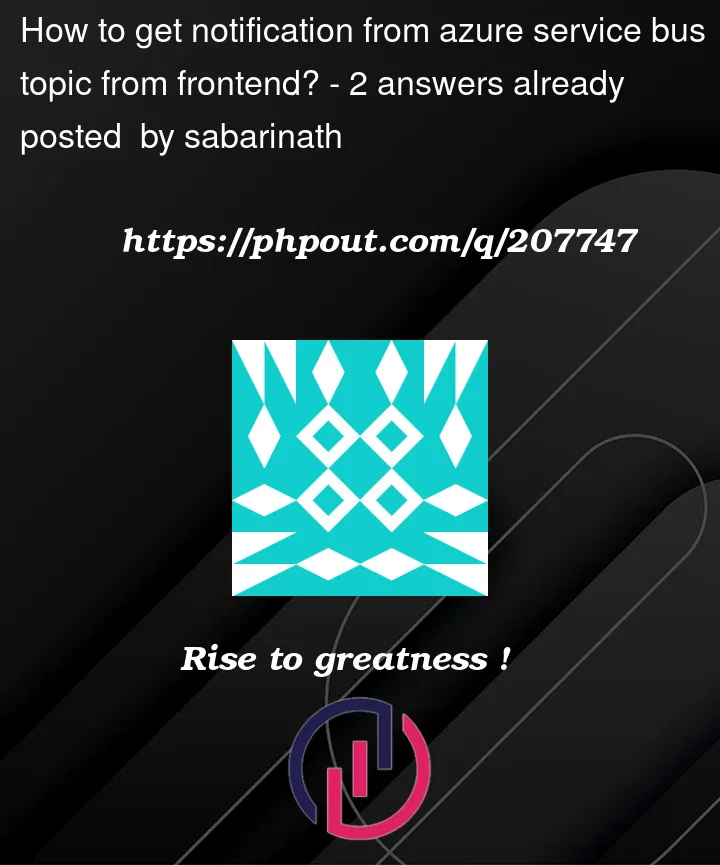we are using azure-service-bus for notification services. in azure portal., service bus topic has been created and message is available in topic. Iam trying to use REST API services to get the topic data.
This is the code I have currently.
import axios from 'axios';
const namespace = 'my-namespace';
const topicName = 'my-topic-name';
const subscriptionId = 'my-subscription-id';
const accesskey = 'my-access-key';
const baseurl = `https://${namespace}.servicebus.windoes.net`;
const url = `${baseurl}/${topicName}/subscriptions/${subscriptionId}`;
const headers = {
Authorization: `SharedAccessSignature ${accesskey}`,
'content-type': 'application/json',
}
const getDetails = async () => {
try {
const response = await axios.get(url, { headers });
console.log('response', response.data);
} catch (error) {
console.error('error', error);
}
}
export default getDetails;I currently have very limited understanding on what is required in frontend. I was trying to use @azure/service-bus., but it is giving error cant resolve 'os' in rhea., webpack < 5 used error.
Hence I tried to eliminate the dependency and used https services.
iam currentlu getting 401 unauthorized error.
can you guide me where iam doing wrong?
updated code as per suggestions:
import axios from 'axios';
import { SHA256 } from 'crypto-js';
const sbName = 'my-sb-name';
const topicName = 'my-topic-name';
const sharedAccessKey = 'my-shared-access-key';
const sharedAccessName = 'RootManagerSharedAccessKey';
const expiry = Math.floor(Date.now() / 1000) + 10000;
const baseUrl = `https://${sbName}.servicebus.windows.net`;
const url = `${baseUrl}/${topicName}`;
const toSign = `${url}n${expiry.toString()}`;
const signature = SHA256(toSign).toString();
const encodedSignature = encodeURIComponent(signature);
const authFormat = `SharedAccessSignature sig={0}&se={1}&skn={2}$sr={3}`;
const auth = authFormat
.replace('{0}', encodedSignature)
.replace('{1}', expiry.toString())
.replace('{2}', sharedAccessName)
.replace('{3}', url);
console.log(auth);
const headers = {
Authorization: auth,
'Content-Type': 'application/json',
};
const getDetails = async () => {
try {
const response = await axios.get(url, { headers });
console.log('Queue Details:', response.data);
// Process the response or update your UI with the retrieved queue details
} catch (error) {
console.error('Error retrieving queue details:', error);
}
};
// Call the function to get queue details
export default getDetails;which gives error: 401 unauthorized




2
Answers
I used
@azure/service-busand configured the dependencies as suggested in their official documentaion and it worked.Iam using
react-scriptsfor myreact 18app. So., inorder to merge the recommended config withreact-scripts., I installed@craco/cracoas dev dependency.in my
craco.config.jsadded following configuration:and in my "scripts" in package.json., replaced
react-scripts starttocraco startas below:in my
getServiceTopicMessage.jsand just import the function in your required page and call. it works
It is because you are providing incorrect authorization key.
You can use the below code to generate the SAS token and then you can use it in the Authorization header to get the topic data.
Code to generate SAS tokenOutputPlease refer ms docs
Use the above generated SharedAccessSignature key in the place of access key of
Authorization: SharedAccessSignature ${access key}.I have used your code without any modification except the access key. I have used the above generated key which gave me the expected result.